class: center, middle # Expressions, Evaluation and Scoping in R ### Deepayan Sarkar <h1 onclick="document.documentElement.requestFullscreen();" style="cursor: pointer;"> <svg xmlns="http://www.w3.org/2000/svg" width="16" height="16" fill="currentColor" class="bi bi-arrows-fullscreen" viewBox="0 0 16 16"> <path fill-rule="evenodd" d="M5.828 10.172a.5.5 0 0 0-.707 0l-4.096 4.096V11.5a.5.5 0 0 0-1 0v3.975a.5.5 0 0 0 .5.5H4.5a.5.5 0 0 0 0-1H1.732l4.096-4.096a.5.5 0 0 0 0-.707zm4.344 0a.5.5 0 0 1 .707 0l4.096 4.096V11.5a.5.5 0 1 1 1 0v3.975a.5.5 0 0 1-.5.5H11.5a.5.5 0 0 1 0-1h2.768l-4.096-4.096a.5.5 0 0 1 0-.707zm0-4.344a.5.5 0 0 0 .707 0l4.096-4.096V4.5a.5.5 0 1 0 1 0V.525a.5.5 0 0 0-.5-.5H11.5a.5.5 0 0 0 0 1h2.768l-4.096 4.096a.5.5 0 0 0 0 .707zm-4.344 0a.5.5 0 0 1-.707 0L1.025 1.732V4.5a.5.5 0 0 1-1 0V.525a.5.5 0 0 1 .5-.5H4.5a.5.5 0 0 1 0 1H1.732l4.096 4.096a.5.5 0 0 1 0 .707z"/> </svg> </h1> --- <div> $$ \newcommand{\sub}[2]{ {#1}_{#2} } \newcommand{\sumlimits}[2]{ \sum\limits_{#1}^{#2} } $$ </div> ## REPL * R works using what is known as a REPL (Read-Eval-Print-Loop) * R waits for user input when it starts * User types input _expression_ and presses `Enter` * R reads input and tries to _evaluate_ * Evaluation is either successful or produces an error * R starts to wait again for further user input * Today's talk takes a closer look at _how the evaluation step works_ -- * Useful links: [Source](https://github.com/deepayan/deepayan.github.io/blob/master/r-talks/r-eval/eval.rmd) (R + Markdown), [Makefile](https://github.com/deepayan/deepayan.github.io/blob/master/r-talks/Makefile) (conversion using [knitr](https://cran.r-project.org/package=knitr) and [pandoc](https://pandoc.org/)), Extracted [R code](https://github.com/deepayan/deepayan.github.io/blob/master/r-talks/r-eval/eval.R) --- ## Prerequisites - Basic R programming - You should be comfortable with writing functions - If you know how to use `eval()` and `quote()`, you already know too much - Statistical concepts used for illustration - Maximum likelihood, regularization - Probability density, histograms - Linear regression --- layout: true ## Evaluation --- * Consider the following expression that we wish to evaluate ```r sqrt(x) ``` ``` Error in eval(expr, envir, enclos): object 'x' not found ``` * This expression involves two "symbols", `sqrt` and `x` * To be able to evaluate the expression, R must be able to "find" both symbols ```r find("sqrt") ``` ``` [1] "package:base" ``` ```r find("x") # not found ``` ``` character(0) ``` --- * So let us define `x` and try again ```r x <- 10 sqrt(x) ``` ``` [1] 3.162278 ``` ```r x <- -1 sqrt(x) ``` ``` Warning in sqrt(x): NaNs produced ``` ``` [1] NaN ``` --- ```r x <- -1+0i sqrt(x) ``` ``` [1] 0+1i ``` ```r x <- "-1" sqrt(x) ``` ``` Error in sqrt(x): non-numeric argument to mathematical function ``` --- * Let us check again where `sqrt` and `x` are found ```r find("sqrt") ``` ``` [1] "package:base" ``` ```r find("x") ``` ``` [1] ".GlobalEnv" ``` --- * Suppose we want to define a "smarter" `sqrt()` * First check what `sqrt()` does, so we can mimic: ```r sqrt ``` ``` function (x) .Primitive("sqrt") ``` * What does `.Primitive()` do? See `help(.Primitive)` (but we don't really need to know) --- * Define a "smart" `sqrt()` as follows: ```r sqrt <- function(x) { orig.sqrt <- .Primitive("sqrt") if (is.character(x)) x <- as.numeric(x) if (is.numeric(x) && any(x < 0)) x <- complex(real = x, imaginary = 0) orig.sqrt(x) } ``` * We now have ```r x <- -1 sqrt(x) ``` ``` [1] 0+1i ``` --- layout: false ## Multiple symbol definitions * Where is R finding these symbols? ```r find("x") ``` ``` [1] ".GlobalEnv" ``` ```r find("sqrt") ``` ``` [1] ".GlobalEnv" "package:base" ``` * Note that the "original" `sqrt()` is not overwritten; instead a new one is defined --- ## The search path * Why is it using the `sqrt` in `".GlobalEnv"` and not the one in `"package:base"`? ```r search() ``` ``` [1] ".GlobalEnv" "package:knitr" "package:stats" "package:graphics" [5] "package:grDevices" "package:utils" "package:datasets" "package:methods" [9] "Autoloads" "package:base" ``` * R searches for symbols sequentially in the "search path" --- ## Environments * What exactly are the objects in the search path? * They are known as "environments", which are central to how evaluation works in R * In essence, an environment is a _collection of symbols_ (variables) bound to _certain values_ * Each environment usually also has an associated "enclosing environment" or "parent environment" * `.GlobalEnv` is the environment where user-defined variables are stored --- ## Environments * The chain of enclosing environments starting from `.GlobalEnv` is identical to the search path ```r e <- .GlobalEnv while (TRUE) { str(e, give.attr = FALSE); e <- parent.env(e) } ``` ``` <environment: R_GlobalEnv> <environment: package:knitr> <environment: package:stats> <environment: package:graphics> <environment: package:grDevices> <environment: package:utils> <environment: package:datasets> <environment: package:methods> <environment: 0x7f9063aa8bb8> <environment: base> <environment: R_EmptyEnv> ``` ``` Error in parent.env(e): the empty environment has no parent ``` ```r search() # compare ``` ``` [1] ".GlobalEnv" "package:knitr" "package:stats" "package:graphics" [5] "package:grDevices" "package:utils" "package:datasets" "package:methods" [9] "Autoloads" "package:base" ``` --- ## Creating and manipulating environments * `new.env()` explicitly creates environments * Variables inside environments can be accessed using `$` (like lists or data frames) ```r e1 <- new.env() e1$x <- seq(0, 2 * pi, length.out = 101) e1$y <- cos(e1$x) plot(y ~ x, data = e1, type = "l", ylim = c(-1, 1)) # Formula interface ``` 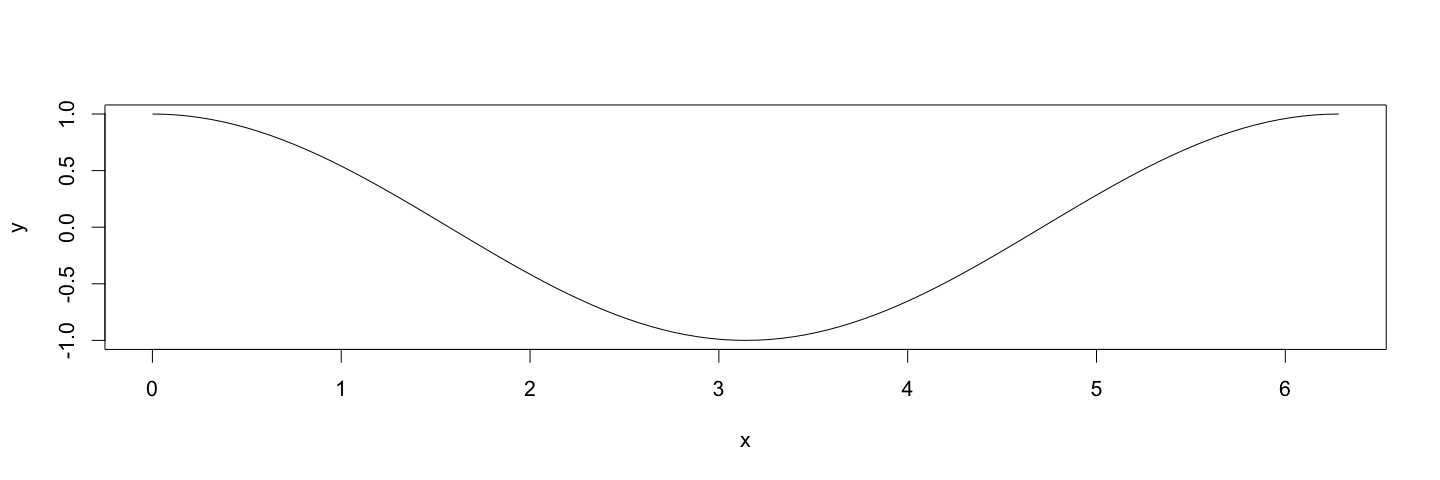 --- ## Environments are not duplicated when copied * Environments are an exception to R's duplicate-on-copy rule * A copy of an environment is the same environment, not a new one ```r e2 <- e1 range(e1$y) ``` ``` [1] -1 1 ``` ```r e2$y <- abs(e2$y) range(e1$y) # changes even though e1$y has not been directly modified ``` ``` [1] 1.608123e-16 1.000000e+00 ``` --- ## Inspecting the variables in an environment * The names of objects available in an environment can be obtained by `ls()` ```r ls(e2) ``` ``` [1] "x" "y" ``` ```r ls.str(e2) ## summary of all objects in e2 ``` ``` x : num [1:101] 0 0.0628 0.1257 0.1885 0.2513 ... y : num [1:101] 1 0.998 0.992 0.982 0.969 ... ``` --- ## Environments and functions * Environments are central to how R functions work * Functions in R are actually ["closures"](https://en.wikipedia.org/wiki/Closure_(computer_programming) * In addition to the argument list and body (code), a function also has an associated environment * This is usually the environment in which the function was defined ```r environment(sqrt) ``` ``` <environment: R_GlobalEnv> ``` ```r environment(base::sqrt) # special "primitive" (C) function, so no environment ``` ``` NULL ``` ```r environment(hist) ``` ``` <environment: namespace:graphics> ``` --- ## What happens when a function is executed? * Every time a function is invoked, a new environment is created * This is the "evaluation environment" and contains the local variables of the function * The environment of the function is the environment enclosing this "evaluation environment" -- * While the function is running, evaluation tries to find symbols as follows: * First, in the evaluation environment * Next, in its enclosing environment, i.e., the environment of the function * Then, in the enclosing environment of that environment, and so on * This behaviour is called "__lexical scoping__" -- * Evaluation in the global environment follows the same rule (hence the search path) --- ## Are these details important to know? * Depends! * You can use R productively with only a superficial understanding of evaluation * However, these details often help explain and diagnose seemingly odd behaviour * They can also be a lot of fun --- ## Example: The Box-Cox transformation * Given positive-valued (possibly skewed) data, one may want to transform them to look Normal * The Box-Cox transformation conveniently combines power transforms and log in a single family * Parameterized by a single parameter $\lambda$ <div> $$ g_\lambda(x) = \begin{cases} \frac{x^\lambda - 1}{\lambda} & \lambda \neq 0 \\ \log x & \lambda = 0 \end{cases} $$ </div> --- layout: true ## Scoping rules can mask errors --- * Consider the following function (which uses an undefined variable `lambda`) ```r boxcox <- function(x) # applies Box-Cox transformation on data 'x' { if (lambda == 0) log(x) else (x^lambda - 1) / lambda } b <- function(x) # computes histogram bins given data 'x' { n <- sum(is.finite(x)) r <- extendrange(x) seq(r[1], r[2], length.out = round(sqrt(n)) + 1) } ``` ```r x <- rlnorm(1000) hist(boxcox(x), breaks = b) # error, as it should be ``` ``` Error in boxcox(x): object 'lambda' not found ``` --- * The same code will "work" if `lambda` happens to be defined ```r lambda <- 0 hist(boxcox(x), breaks = b) # notice that 'b' is a function! (See ?hist) ``` 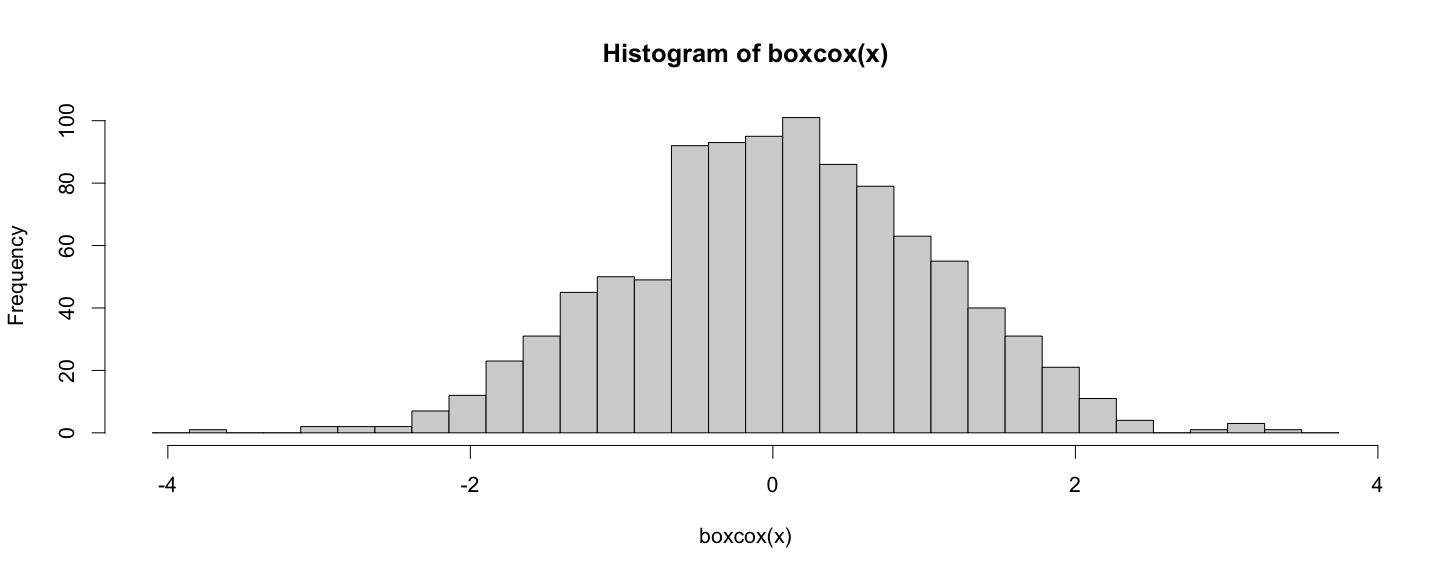 --- layout: false ## But sometimes we _want_ to write such functions * Normally, depending on this kind of scoping behaviour should be unnecessary * In fact, a well-designed function should not depend on arbitrary variables * However, there is one situation where this evaluation rule becomes important * When a function creates and returns or uses another function! --- ## Do we need functions that create functions? * Probably not very common... * But only because we are limited in our thinking * We already use functions as arguments to other functions * Thinking "functionally" opens up many other interesting approaches * This is particularly useful for quick prototyping --- ## Do we need functions that create functions? * A somewhat silly extension of the example above: ```r fboxcox <- function(lambda) { f <- function(x) { if (lambda == 0) log(x) else (x^lambda - 1) / lambda } return(f) } ``` ```r boxcox.sqrt <- fboxcox(0.5) boxcox.log <- fboxcox(0) ``` --- ## Do we need functions that create functions? ```r par(mfrow = c(1, 2)) hist(boxcox.sqrt(x), breaks = b) # equivalently, hist(fboxcox(0.5)(x), breaks = b) hist(boxcox.log(x), breaks = b) # hist(fboxcox(0)(x), breaks = b) ``` 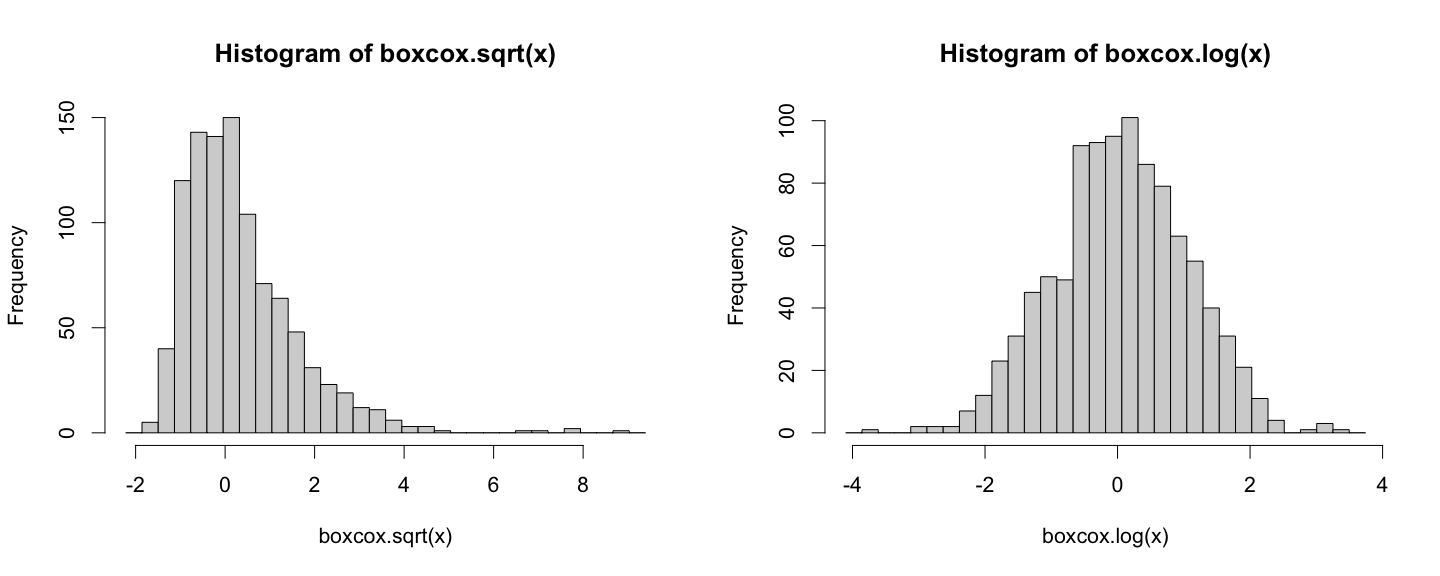 --- ## Functions returned by functions * Note that `boxcox.sqrt` and `boxcox.log` are both functions (created by another function `fboxcox`) ```r boxcox.sqrt ``` ``` function(x) { if (lambda == 0) log(x) else (x^lambda - 1) / lambda } <environment: 0x7f90676098a8> ``` ```r boxcox.log ``` ``` function(x) { if (lambda == 0) log(x) else (x^lambda - 1) / lambda } <bytecode: 0x7f90636851f0> <environment: 0x7f9067669b98> ``` * ... that appear to be identical --- ## Functions returned by functions * But they have different "environments" ```r environment(boxcox.sqrt) ``` ``` <environment: 0x7f90676098a8> ``` ```r environment(boxcox.log) ``` ``` <environment: 0x7f9067669b98> ``` --- ## Functions returned by functions * This is because they were created in different executions of `fboxcox()` * Although not immediately apparent, these environments retain the value of `lambda` ```r ls.str(environment(boxcox.sqrt)) ``` ``` f : function (x) lambda : num 0.5 ``` ```r ls.str(environment(boxcox.log)) ``` ``` f : function (x) lambda : num 0 ``` --- ## Functions returned by functions * Without lexical scoping, this would not have been possible * Another example from [The R Paper](https://www.stat.auckland.ac.nz/~ihaka/downloads/R-paper.pdf): ```r y <- 123 f <- function(x) { y <- x * x g <- function() print(y) g() } f(10) ``` ``` [1] 100 ``` * S, which is similar to R but does not have lexical scoping, would print `123` --- ## A more serious example * Suppose we want to transform (positive-valued) data $x_1, x_2, \dotsc, x_n$ -- * ... to look as Normal as possible, but we don't know what the correct transformation should be * A standard textbook solution is to look for an "optimum" choice within the Box-Cox family * A maximum-likelihood approach: assume $\lambda$-transformed data follow $N(\mu, \sigma^2)$ -- * A [little mathematics](https://www.isid.ac.in/~deepayan/RT2018/notes/systematic-violations.html#/the-box-cox-transformation-a-likelihood-based-approach) tells us that - There is no closed form solution for $\lambda$, but - The optimum (MLE) $\lambda$ can be found by minimizing $$ f(\lambda) = \frac{n}{2} \left( \log 2 \pi + \log \hat{\sigma}^2(\lambda) + 1 \right) - (\lambda - 1) \sum \log \sub{x}{i} $$ - where $\hat{\sigma}^2(\lambda)$ is the sample variance of the transformed data -- * Here $f$ is a function, which is itself a function of data $x_1, x_2, \dotsc, x_n$ --- layout: true ## A quick prototype --- * Suppose we have a general numerical optimizer that can optimize a function of _one_ argument * Make a function that converts data into a function suitable for optimization: ```r negllBoxCox <- function(x) { n <- length(x) slx <- sum(log(x)) # compute only once function(lambda) { y <- fboxcox(lambda)(x) # Note use of fboxcox() defined earlier sy <- mean((y - mean(y))^2) n * log(sy) / 2 - (lambda - 1) * slx # ignoring constant terms } } ``` --- * Let's compute the "negative log likelihood" function for some simulated data ```r x <- rlnorm(100) # log-normal, so true lambda = 0 f <- negllBoxCox(x) f(0) ``` ``` [1] 4.311438 ``` * We can can now use this function in any optimizer ```r optimize(f, lower = -10, upper = 10) ``` ``` $minimum [1] -0.1608655 $objective [1] 2.230694 ``` ```r ## OR optim(par = 1, fn = f) for alternative methods ``` --- * We can even plot $f$ — but first we have to "vectorize" our function * The `Vectorize()` function creates a vectorized function from a non-vectorized one ```r plot(Vectorize(f), from = -2, to = 2, n = 1000, las = 1) ``` 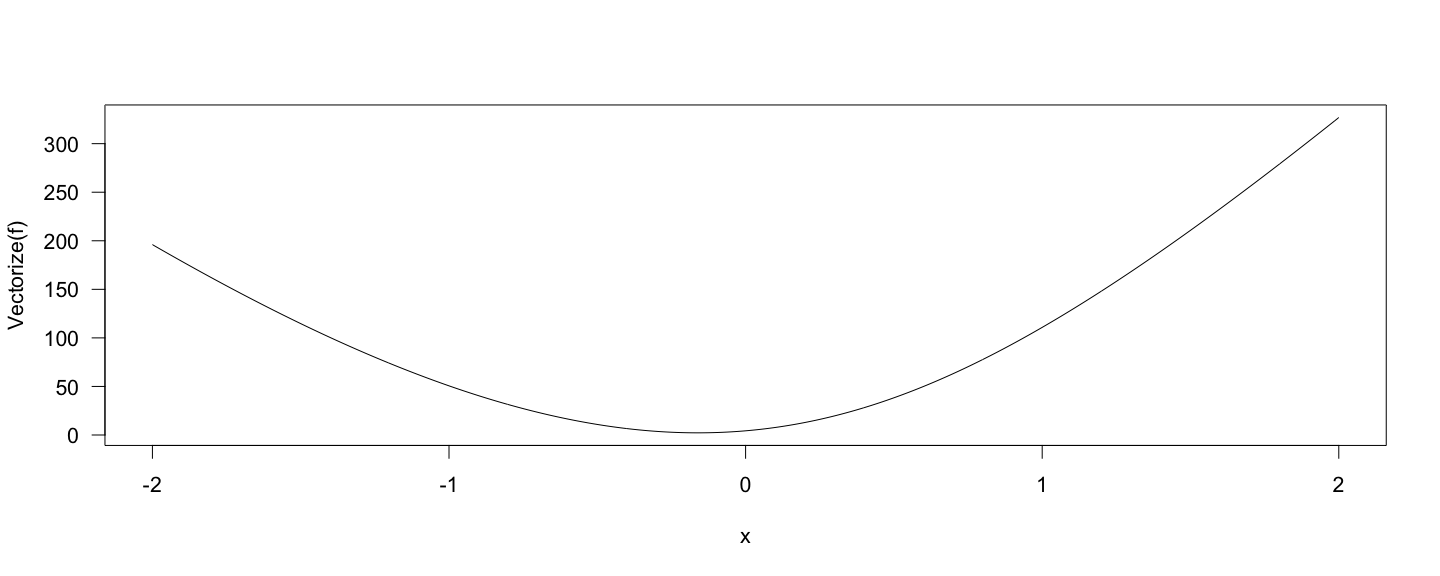 --- * We can also do a quick simulation study of how well this method estimates $\lambda$ when the true $\lambda = 1$ ```r lambda.hat <- replicate(1000, optimize(negllBoxCox(rnorm(100, mean = 10)), lower = -10, upper = 10)$minimum) hist(lambda.hat, breaks = b, las = 1) ``` 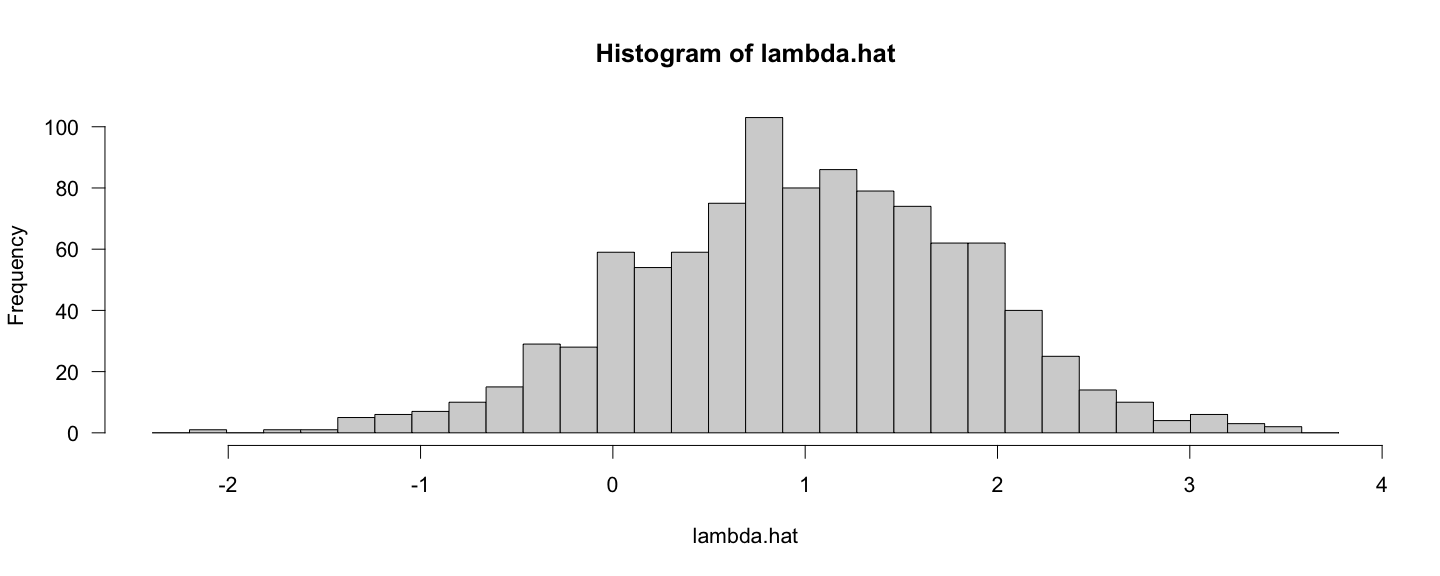 --- layout: false ## Another example: linear regression with general loss function * Another common use case: optimization of a loss function * Consider the following general approach to linear regression given data $(\sub{x}{i}, \sub{y}{i}), i = 1,\dotsc,n$ <div> $$ \hat{\beta} = \arg \min_{\beta} \sumlimits{i=1}{n} L(\sub{y}{i} - \sub{\beta}{0} - \sub{\beta}{1} \sub{x}{i}) = \arg \min_{\beta} f(\beta) $$ </div> * Common choices for $L$ are * $L(u) = u^2$ * $L(u) = | u |$ * <div>$L(u) = \begin{cases} u^2 & \lvert u \rvert \leq c \\ c (2 | u | - c) & \text{otherwise} \end{cases}$</div> --- layout: true ## Objective functions (to be optimized) --- * The following functions takes data and $L$, and creates a suitable objective function ```r make.objective <- function(x, y, L = abs) { function(beta) { sum(L(y - beta[1] - beta[2] * x)) } } data(phones, package = "MASS") obj.lad <- with(phones, make.objective(year, calls, L = abs)) obj.lse <- with(phones, make.objective(year, calls, L = function(u) u*u)) ``` --- ```r obj.lad ``` ``` function(beta) { sum(L(y - beta[1] - beta[2] * x)) } <environment: 0x7f9061b191e8> ``` ```r environment(obj.lse)$L ``` ``` function(u) u*u <environment: 0x7f9061bad478> ``` ```r environment(obj.lad)$L ``` ``` function (x) .Primitive("abs") ``` --- layout: true ## Results of optimization --- ```r fm.lad <- optim(obj.lad, par = c(0,0)) fm.lse <- optim(obj.lse, par = c(0,0)) str(fm.lad) ``` ``` List of 5 $ par : num [1:2] -66.05 1.35 $ value : num 844 $ counts : Named int [1:2] 117 NA ..- attr(*, "names")= chr [1:2] "function" "gradient" $ convergence: int 0 $ message : NULL ``` ```r str(fm.lse) ``` ``` List of 5 $ par : num [1:2] -260.12 5.04 $ value : num 69544 $ counts : Named int [1:2] 109 NA ..- attr(*, "names")= chr [1:2] "function" "gradient" $ convergence: int 0 $ message : NULL ``` --- ```r plot(calls ~ year, phones) abline(fm.lad$par, col = "blue") abline(fm.lse$par, col = "red") # This is what we would get from lm() ``` 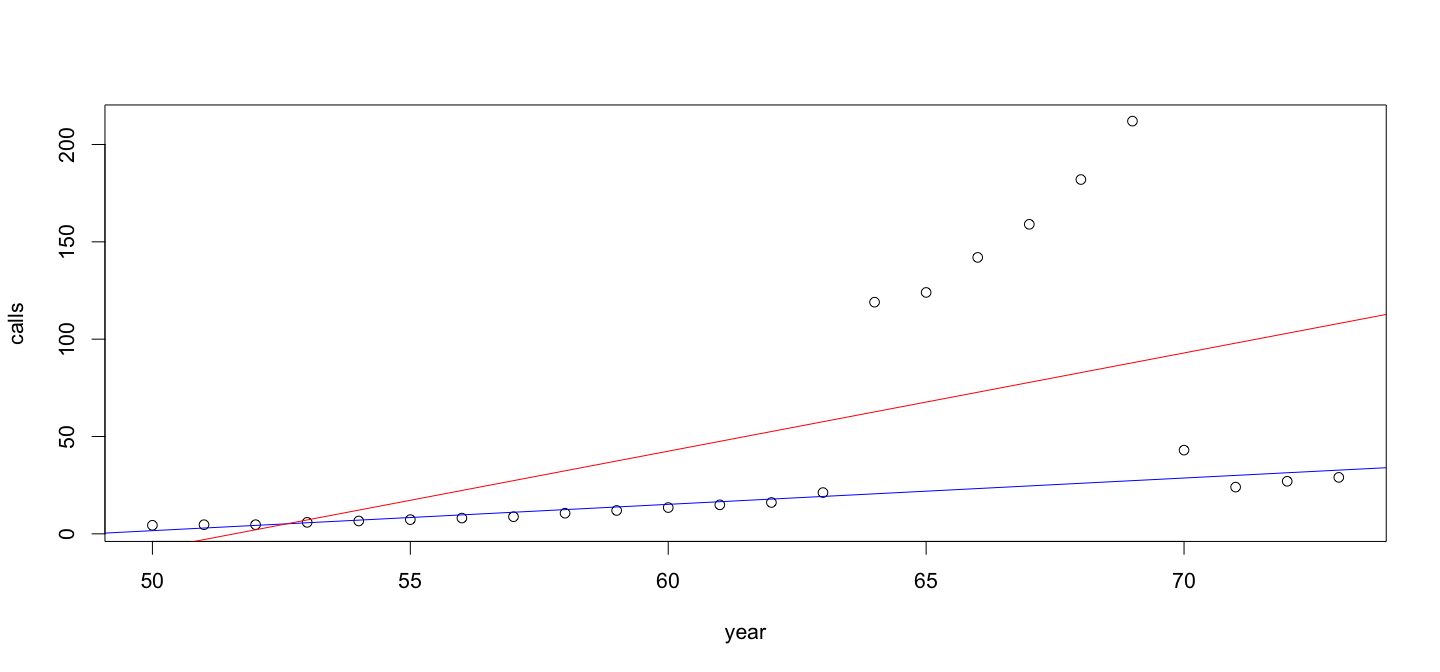 --- layout: false ## A more complex example * Suppose we want to plot a histogram * One important parameter is the bin width $h$ * Fixing starting point, what is an optimal choice? * Maximum Likelihood fails because it "oversmooths", so needs regularization * Options * [AIC](https://en.wikipedia.org/wiki/Akaike_information_criterion) * [cross validation](http://onlinestatbook.com/stat_sim/histogram/index.html) --- ## Minimize AIC * The Akaike Information Criterion is a popular model selection criterion * Simple definition: $2k - 2 \log(\hat{L})$ where - $k$ is the number of parameters (here the number of bins) - $\hat{L}$ is the maximum likelihood (here the joint density under the histogram) * Our prototype: make function of $k$ from input data --- ## AIC for histograms ```r chooseBinsAIC <- function(x, p = 0.25) { x <- x[is.finite(x)] n <- length(x) r <- extendrange(x) d <- r[2] - r[1] histAIC <- function(B) { b <- seq(r[1], r[2], length.out = B + 1) h <- hist(x, breaks = b, plot = FALSE) ## likelihood is simply product of density^counts keep <- h$counts > 0 # skip 0 counts (by convention 0 log 0 == 0) logL <- with(h, sum(counts[keep] * log(density[keep]))) 2 * B - 2 * logL } Bvec <- seq(floor(sqrt(n)*p), ceiling(sqrt(n)/p)) list(range = r, B = Bvec, AIC = unname(sapply(Bvec, histAIC))) } ``` --- ## AIC: implementation ```r xx <- c(rnorm(500), rnorm(300, mean = 6, sd = 1.5)) ll <- chooseBinsAIC(xx, p = 0.125) str(ll) ``` ``` List of 3 $ range: num [1:2] -3.79 11.35 $ B : int [1:225] 3 4 5 6 7 8 9 10 11 12 ... $ AIC : num [1:225] 4146 4115 3876 3736 3723 ... ``` --- ## AIC: implementation ```r with(ll, { plot(AIC ~ B, type = "o") abline(v = B[which.min(AIC)]) }) ``` 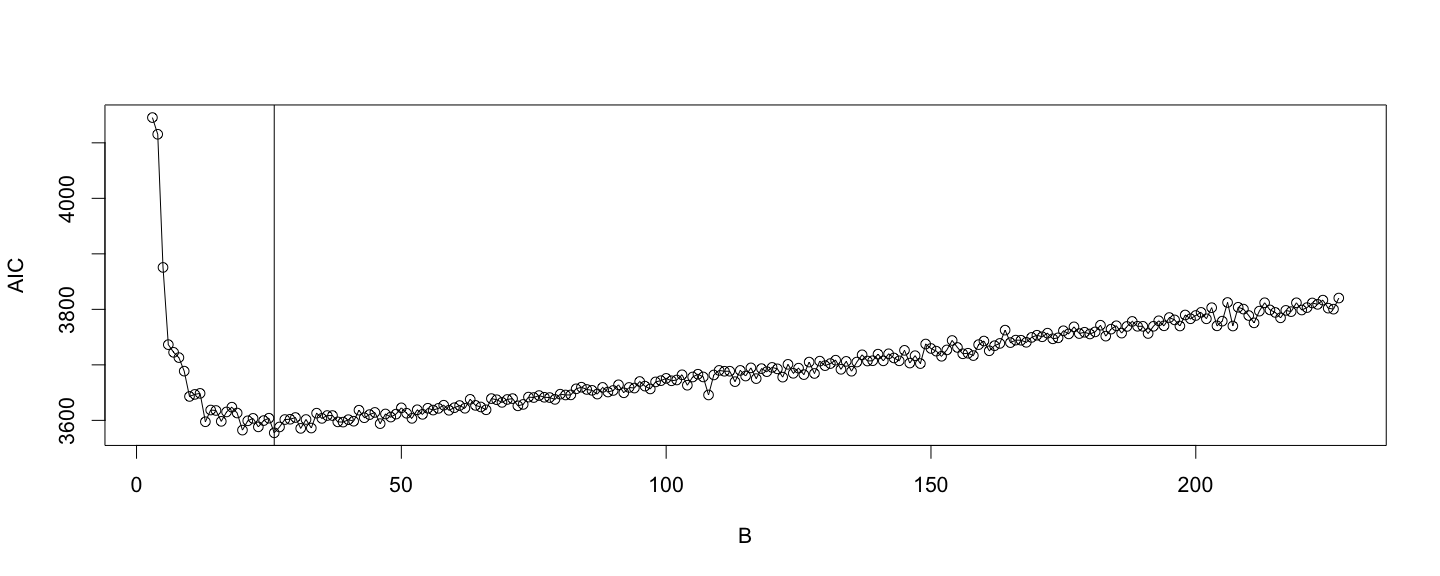 --- ## AIC: comparison with other "rules" ```r (nclass.aic <- with(ll, B[which.min(AIC)])) ``` ``` [1] 26 ``` ```r nclass.Sturges(xx) ``` ``` [1] 11 ``` ```r nclass.FD(xx) ``` ``` [1] 12 ``` ```r nclass.scott(xx) ``` ``` [1] 12 ``` --- ## AIC: Resulting histogram ```r breaks <- seq(ll$range[1], ll$range[2], length.out = nclass.aic + 1) hist(xx, breaks = breaks) ``` 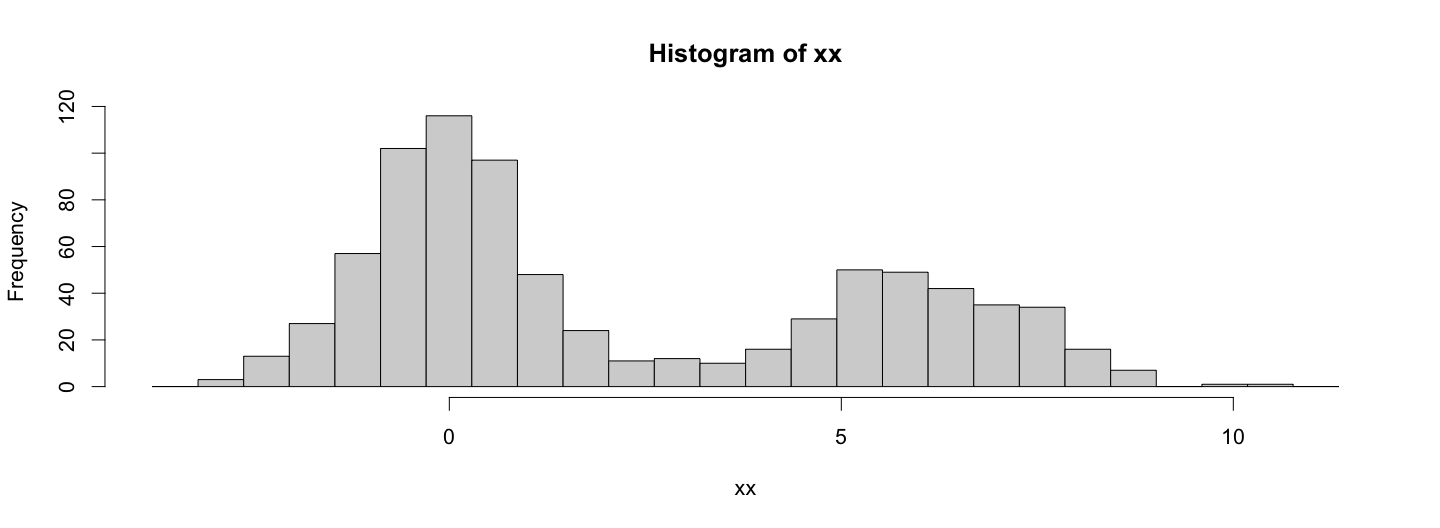 --- ## Cross validation: summary $\newcommand{\fhath}{\hat{f}_h}$ * Denote the histogram for bin width $h$ by $\fhath$, and the unknown density by $f$ * Want to choose $h$ to minimize integrated square error $$ \int \left[ \fhath(x) - f(x) \right]^2 dx = \int \fhath(x)^2 dx - 2 \int \fhath(x)\, f(x)\, dx + \int f(x)^2 dx $$ * The third term is unknown but constant (as $h$ varies), so can be dropped * The first term can be calculated from $\fhath$ (which is piecewise constant) * The second term involves the unknown $f$, but the integral can be viewed as $E(\fhath(X))$ when $X \sim f$ --- ## Cross validation: summary * Leave-one-out estimator: average of ${\fhath}_{(-i)}(x_i)$ * The estimated integrated square error (without the constant term) simplifies to $$ \frac{2}{(n-1) h} - \frac{n+1}{(n-1) n^2 h} \sum_{k} c_k^2 $$ * where $c_k$ are bin counts --- ## Cross validation: implementation ```r chooseBins <- function(x, p = 0.25) { x <- x[is.finite(x)] n <- length(x) r <- extendrange(x) d <- r[2] - r[1] CVE <- function(B) { h <- d / B breaks <- seq(r[1], r[2], length.out = B+1) k <- findInterval(x, breaks) # runtime O(n * log(B)) counts <- table(factor(k, levels = 1:B)) 2 / ((n-1)*h) - sum(counts^2) * (n+1) / ((n-1) * n^2 * h) } Bvec <- seq(floor(sqrt(n)*p), ceiling(sqrt(n)/p)) list(range = r, B = Bvec, CVE = unname(sapply(Bvec, CVE))) } ``` --- ## Cross validation: implementation ```r ## xx <- c(rnorm(500), rnorm(300, mean = 6, sd = 1.5)) ll <- chooseBins(xx, p = 0.125) str(ll) ``` ``` List of 3 $ range: num [1:2] -3.79 11.35 $ B : int [1:225] 3 4 5 6 7 8 9 10 11 12 ... $ CVE : num [1:225] -0.0831 -0.0802 -0.1034 -0.1207 -0.1195 ... ``` --- ## Cross validation: implementation ```r with(ll, { plot(CVE ~ B, type = "o") abline(v = B[which.min(CVE)]) }) ``` 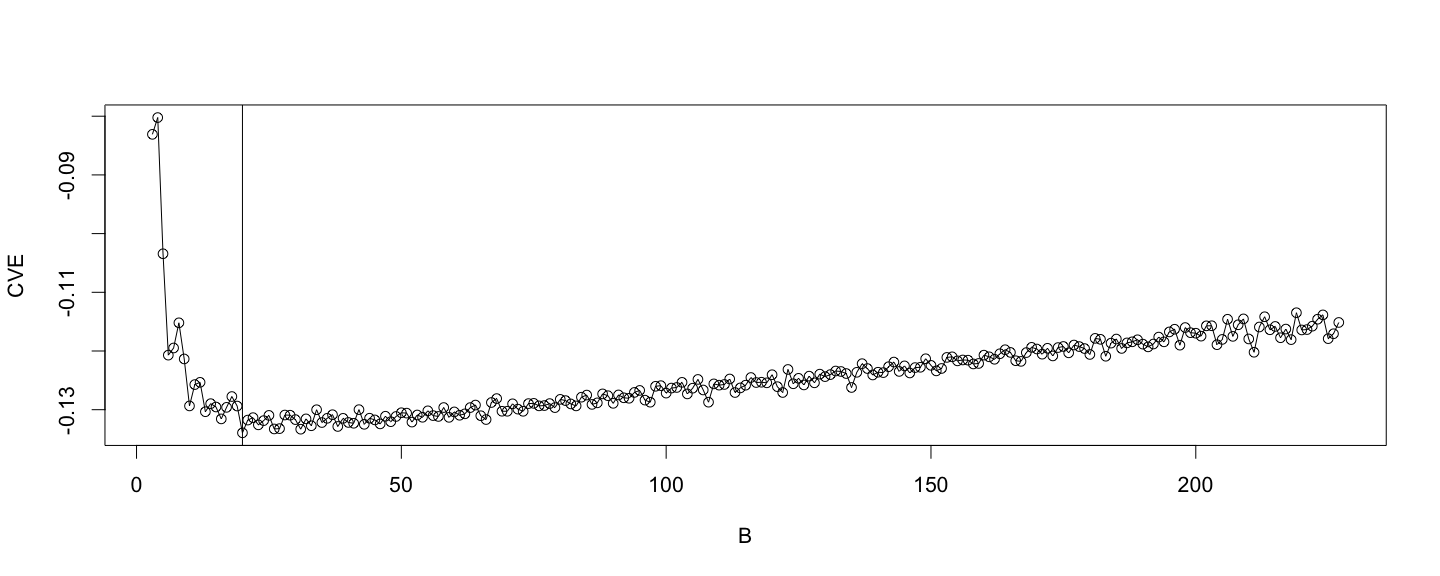 --- ## Cross validation: comparison with other "rules" ```r (nclass.cv <- with(ll, B[which.min(CVE)])) ``` ``` [1] 20 ``` ```r nclass.Sturges(xx) ``` ``` [1] 11 ``` ```r nclass.FD(xx) ``` ``` [1] 12 ``` ```r nclass.scott(xx) ``` ``` [1] 12 ``` --- ## Cross validation: Resulting histogram ```r breaks <- seq(ll$range[1], ll$range[2], length.out = nclass.cv + 1) hist(xx, breaks = breaks) ``` 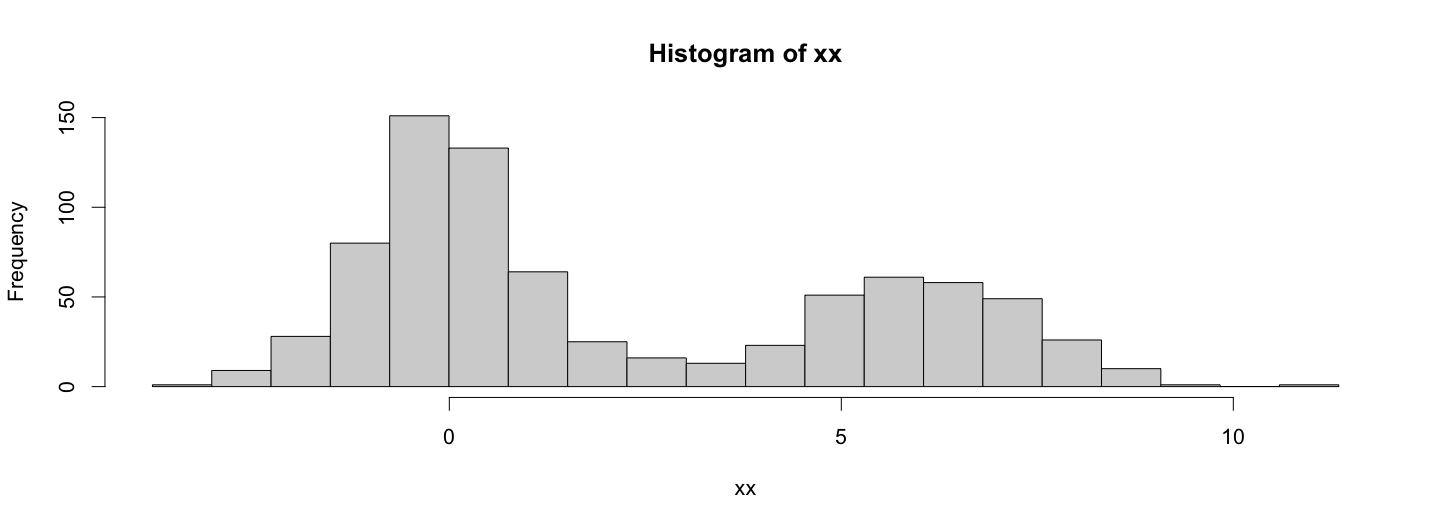 * For more interesting examples, see Gentleman and Ihaka, [Lexical Scope and Statistical Computing](https://www.stat.auckland.ac.nz/~ihaka/downloads/lexical.pdf) --- ## Related topic: non-standard evaluation * Again, consider an expression that will cause an error when evaluated ```r rm(list = c("x", "y")) # remove x, y if defined earlier plot(x, y, type = "l") ``` ``` Error in plot(x, y, type = "l"): object 'x' not found ``` --- ## Quoted (unevaluated) expressions * R can actually work with an expression without evaluating it ```r e <- quote(plot(x, y, type = "l")) e ``` ``` plot(x, y, type = "l") ``` ```r e[[1]] ``` ``` plot ``` ```r e[[2]] ``` ``` x ``` ```r e[[3]] ``` ``` y ``` --- ## Evaluating Quoted expressions * A quoted expression can be evaluated using `eval()` ```r eval(e) ``` ``` Error in plot(x, y, type = "l"): object 'x' not found ``` * Fails because current environment (`.GlobalEnv`) does not contain variables `x` and `y` * But Recall: Environment `e2` defined earlier contains ```r ls.str(e2) ``` ``` x : num [1:101] 0 0.0628 0.1257 0.1885 0.2513 ... y : num [1:101] 1 0.998 0.992 0.982 0.969 ... ``` --- ## Evaluating Quoted expressions ```r eval(e, envir = e2) ``` 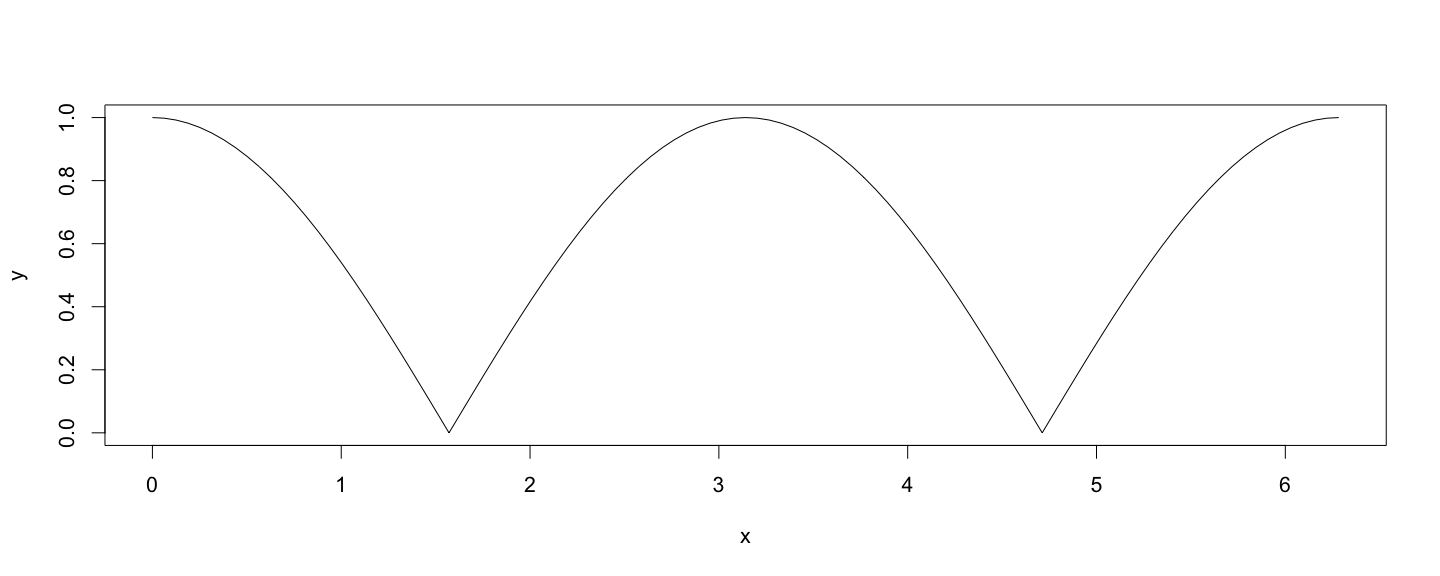 --- ## Can we re-implement the `replicate()` function? * This is how functions like `replicate()` and `with()` work ```r my.replicate <- function(N, e) { ans <- numeric(N) for (i in 1:N) ans[[i]] <- eval(e) ans } ``` * But we have to be careful to use it ```r my.replicate(5, max(rnorm(10))) # not what we wanted ``` ``` [1] 2.1574 2.1574 2.1574 2.1574 2.1574 ``` ```r my.replicate(5, quote(max(rnorm(10)))) ``` ``` [1] 0.5284321 0.6858938 1.3573033 0.8895072 1.6434051 ``` --- ## Non-standard evaluation * The `substitute()` trick: non-standard evaluation (using lazy argument evaluation) ```r my.replicate <- function(N, e) { expr <- substitute(e) # avoids the need to quote() ans <- numeric(N) for (i in 1:N) ans[[i]] <- eval(expr) ans } str(x <- my.replicate(1000, max(rnorm(20)))) ``` ``` num [1:1000] 1.648 2.524 1.636 1.346 0.729 ... ``` --- ## Lazy evaluation * Lazy evaluation: function arguments are only evaluated when needed ```r set.seed(123) rm(sqrt) # remove the sqrt() we defined earlier chooseOne <- function(a, b, u = runif(1)) { if (u < 0.5) a else b } ``` * Only one of `a` and `b` is evaluated in any particular execution ```r chooseOne(sqrt(2), sqrt(-2)) # no warning message ``` ``` [1] 1.414214 ``` ```r chooseOne(sqrt(2), sqrt(-2)) # warning message ``` ``` Warning in sqrt(-2): NaNs produced ``` ``` [1] NaN ``` --- ## Further reading ```r ? environment ? eval ? expression ? quote ? bquote ? substitute ? with ``` ```r with.default ``` ``` function (data, expr, ...) eval(substitute(expr), data, enclos = parent.frame()) <bytecode: 0x7f9061b19fb0> <environment: namespace:base> ``` ```r replicate ``` ``` function (n, expr, simplify = "array") sapply(integer(n), eval.parent(substitute(function(...) expr)), simplify = simplify) <bytecode: 0x7f9061ac9e08> <environment: namespace:base> ```